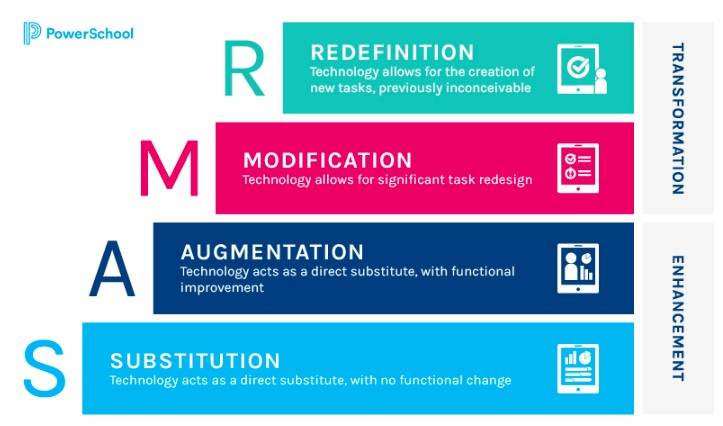
I spent quite a bit of time in homeschool and did about 50% of my undergrad during the pandemic. I found this lecture really encapsulated the importance of video and multimedia in my learning journey. I could not have completed my math without Kahn Academy, learned to love books without Goodreads, or make it through my literature degree without spark notes. I think each of this things have the capacity to hinder learning, but used well, the power to enhance it as well.
Summary (What)
Michael spoke about the creativity involved in using technology in the class from a design standpoint. The image below gives an idea of different types of technology in the classroom and what purpose they serve. Tools like this one are useful as you decide what technology to include in your classroom, when, and how. Even in Michael’s presentation when he used an image similar to this one, he cropped it in such a way that with every new slide we saw slightly more of the image. Not only is this a great way to demonstrate the things we can do with technology in the classroom, it gave us an example of how to limit distractions while we are planning for our lessons.
Constructive alignment is key when we are planning to use technology in our classes. Everything we do in class is taking us to some outcome, right down to the technology we use, the activities we incorporate, and the discussions we lead. As we plan and use technology we should reflect on how this impacts students. Is it distracting? Is it helpful? Is the technology getting in the way of the learning goal or aiding it? (Is it impeding students in an assignment or overstimulating them?)
After giving us examples of ways to use multimedia in our classrooms (imbedding videos and podcasts, using photos to explain) he explained the importance of using dual coding. This means both audio and visual methods of learning to help students remember information better.
I think this is a great way of keeping students engaged with the material. Whether the video is a YouTube embedded (to avoid the ads) or a video I made myself with a voice that is familiar to my students (to make it seem more authentic), video has a great place in the classroom.
- It can be rewatched by students when they want to go back to remember how to do something or want something reexplained.
- It can be watched when the students are most prepared to hear it (sometimes this is at home away from distracting peers or an overstimulating school environment).
- Video can be more entertaining for some school subjects than teaching it in a classroom.
- Video and multimedia can be heard and seen and so supports the dual coding process.
So what?
I spoke with my mom recently (a grade 2 teacher) who recommended I use visual timers in my classroom because it is a great way to remind students how long they have left on the task they are working on and how long they need to focus for. After a moment, she quickly said “Oh but be cautious about the timer noise and always make sure it is either silent or a calming sound!”. She was really adamant that a loud buzzer or anything else loud and shocking will overstimulate many kids and frustrate others. At best it will make them jump, at worst it will set students off and they might have a terrible rest of their day trying to self-regulate. I had never thought of this before and it is a great reminder that we need to be super aware of how the technology we use in our class might affect our students.
Watch the last few seconds of this video and you can see how this might be detrimental for many students. Not only is the background of the timer incredibly distracting (and somewhat dizzying), but the buzzer is abrupt and annoying.
This timer is calming with nice background music, nature sounds, and no timer sound at the end (the video simply ends). While this is relaxing it might also be distracting and the lack of a sound at the end might null the point of having a timer at all.
This last option is a simple black and white video with only minimal sounds at the end to indicate the last five seconds have arrived. Something like this could be a great option for silent reading time as it gently brings students back to the classroom and indicates the end of reading time.
The point of these three videos is to demonstrate my mom’s point that every decision counts in the classroom. A digital timer is helpful for displaying the time left in the activity for students, but things like noise, images, ads, and buzzer sounds can seriously detract from the positives.
This is another reason embedding videos is a really good idea. When you watch a video on YouTube the students are able to see video recommendations (which, if using your personal account, might feel a bit vulnerable), ad pop ups, and other distracting things. When a video is embedded it reduces the distractions while making it more convenient.
Now what?

This is am image like the one used in class and below is an example of how to present this in class in an organized and less distracting way. This took me 3 minutes to create the slides and record this video. It is not a difficult thing to do.
Things like videos in class are really important as well. I took a couple of really challenging history classes in my undergrad and John Green”s “Crash Course” is a great example of how I was able to use YouTube to understand what the heck was going on in these super boring 3-hour-long lectures. Like this crash course on US history (this is a long series but here he introduces what will be covered).
I think, moving forward, I will enjoy using technology in my class as I found it incredibly useful as a student. This lesson and the proceeding conversation with my mom has made me realize how much I need to pay attention to what might take away from the experience of using technology in my classroom and to keep in mind the state of the children I will be teaching.